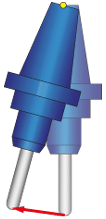Machine simulation: Collision Control
This page enables you to define the following settings:
Enable collision control
This option enables you to detect and avoid possible collisions between all components of the CNC-Machine in the process of machining. When the Enable collision control check box is selected, SolidCAM performs the collision checking according to the collision control parameters in the CNC-Machine definition. When the Enable collision control check box is not selected, SolidCAM ignores the collision control parameters in the CNC-Machine definition and does not perform the collision control.
Collision check tolerance
This parameter enables you to specify the tolerance of the collision check. SolidCAM ignores all the collisions with tolerance smaller than the specified value and alerts when the collision tolerance is greater than the tolerance specified value.
|
This value should correspond to that of the Facet tolerance parameter defined in the Stock and Target Model dialog box to avoid cases when collisions are detected because of inconsistency between these tolerance values. |
Part offset
This parameter enables you to add a virtual offset surrounding the whole part at the specified distance. Collisions occurring within this boundary will be ignored.
Collision detection mode
Generally, SolidCAM performs the collision control in the generated tool path positions listed in the GCode output.
Collision check in length-based mode
This section enables you to perform the collision check when the Length-based Mode is chosen.
Maximum distance
This parameter enables you to specify the step between two consecutive checking positions.
Maximum angle change
This parameter enables you to specify the maximal angle change allowed for the tool per each move.
When stock is split by CutOff operation
Enable Use Fixture Clamping - In a Cutoff operation after the stock is split, the split stock remains on the main spindle and the remaining stock with part moves with the Back spindle to the desired location.
Disable Use Fixture Clamping - In a Cutoff operation after the stock is split, the entire split stock with part moves with the Back spindle to the desired location.
